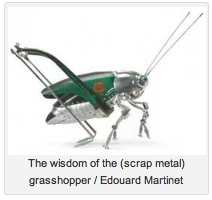It is a radical re-think of the “extractive economy,” notes Ryan Smith, Micromidas’ CTO. After a few centuries of hauling finite resources—from fossil fuels to rare earth minerals—out of the ground, we have enough on the surface to keep us going, and in fairly good style, but only if we refocus our collective tech smarts and investment dollars on mining garbage.
Drilling for oil and refining it into a form that can be used to make a plastic bottle, for example, is a long, complicated giant-carbon-footprint process. When the bottle is tossed, the energy embedded in its manufacture is lost as well.
From Terracycle, an “upcycling” company that turns juice pouches into pop culture-stylish backpacks and sells worm poop fertilizer in re-used plastic bottles, to Recycle Match, whose founder refers to the company as the “eBay of garbage,” the focus is on keeping as much as possible from needlessly ending up in landfills.
Likewise, Oregon-based clothing manufacturer Looptworks, creates limited edition fashion lines from high-quality “pre-consumer” waste, a.k.a. surplus fabric that mills and manufactures otherwise simply discard. Nearly 12 billion pounds of textile waste is produced annually just in the U.S.—much of it destined for landfills. They have rejiggered the traditional fashion business model by creating smaller runs that require less lead time (a couple of months versus a year, or more), sourcing great fabrics at bargain prices and streamlining the distribution network, using the internet both for direct sales and developing a national retail network. Lower labor, material and distribution costs drop straight to the bottom line.
Ecovative Design wants to keep styrofoam out of landfills, not by re-using it, but replacing it with a product whose production itself diverts would-be agricultural waste streams from landfills. Founder Eben Bayer and his team developed a process that infuses crop byproducts packed into special molds with mushroom mycelium. In less than a week, the mycelium consume the ag waste, creating a sturdy biodegradable polymer in whatever shape the mold happened to be. Instead of throwing away packing materials, consumers can compost them for their gardens. Even if the material ends up in a landfill, it will break down quickly, unlike styrene, which can last for millennia. Also, because the “mycobond” process requires comparatively little investment in machinery—the fungus does most of the heavy-lifting—and can be adapted for a broad range of ag waste material, it lends itself for a distributed production network. That means yet another level of carbon-footprint savings shipping product over shorter distances.
- Laptop that can be dis-assembled for recycling in 10 steps, 2 minutes, with no tools
- Biomimicry Institute’s “Ask Nature” database—a must-use for designers and architects
- World champion sailor-turned-eco-activist Ellen MacArthur’s video on the circular economy
- Breakthrough for recycling laminated paper wrappers
- and more!










